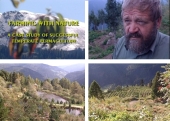
 2
2












Miles Flansburg wrote:
It seems to me that standing water, like a pond, would have time to soak through all of the clay layers?
"You must be the change you want to see in the world." "First they ignore you, then they laugh at you, then they fight you, then you win." --Mahatma Gandhi
"Preach the Gospel always, and if necessary, use words." --Francis of Assisi.
"Family farms work when the whole family works the farm." -- Adam Klaus








 1
1




Miles Flansburg wrote:Ah, good call R Scott!
So the cure seems to be roots?
"You must be the change you want to see in the world." "First they ignore you, then they laugh at you, then they fight you, then you win." --Mahatma Gandhi
"Preach the Gospel always, and if necessary, use words." --Francis of Assisi.
"Family farms work when the whole family works the farm." -- Adam Klaus
 1
1












"You must be the change you want to see in the world." "First they ignore you, then they laugh at you, then they fight you, then you win." --Mahatma Gandhi
"Preach the Gospel always, and if necessary, use words." --Francis of Assisi.
"Family farms work when the whole family works the farm." -- Adam Klaus




 1
1




Karen Walk wrote:how can water landscapes help rejuvenate areas with heavy, low - permeability soils.




Marcus Hoff wrote:What a good idea - how do you find the bedrock contours?
"You must be the change you want to see in the world." "First they ignore you, then they laugh at you, then they fight you, then you win." --Mahatma Gandhi
"Preach the Gospel always, and if necessary, use words." --Francis of Assisi.
"Family farms work when the whole family works the farm." -- Adam Klaus
 2
2




Zach Weiss wrote:My guess would be that the second impermeable layer your are finding (underneath the wet clay) is the "natural" impermeable layer, and the first layer of hard compacted clay is the result of poorly managed animal grazing.
 1
1




Windward Sustainability Education and Research Center
Permaculture Apprenticeships at Windward
America's First Permaculture Cemetery? Herland Forest Natural Burial Cemetery








Karen Walk wrote:Hi Andrew,
How is they keyline working for you? I have lots of compacted pasture and am planning to start with keyline this spring.
 since I have yet to find something that we can work with.
since I have yet to find something that we can work with. Windward Sustainability Education and Research Center
Permaculture Apprenticeships at Windward
America's First Permaculture Cemetery? Herland Forest Natural Burial Cemetery




"You must be the change you want to see in the world." "First they ignore you, then they laugh at you, then they fight you, then you win." --Mahatma Gandhi
"Preach the Gospel always, and if necessary, use words." --Francis of Assisi.
"Family farms work when the whole family works the farm." -- Adam Klaus




"You must be the change you want to see in the world." "First they ignore you, then they laugh at you, then they fight you, then you win." --Mahatma Gandhi
"Preach the Gospel always, and if necessary, use words." --Francis of Assisi.
"Family farms work when the whole family works the farm." -- Adam Klaus








R Scott wrote:Andrew:
What do you have to work with?
Karen Walk wrote:
Your tiller mod sounds like a good option for small spaces. For the larger areas check out open source ecology. I know that someone over there was working on a keyline plow. I'm lucky in that someone in the area has a good keyline plow, and knows how to use it!
Windward Sustainability Education and Research Center
Permaculture Apprenticeships at Windward
America's First Permaculture Cemetery? Herland Forest Natural Burial Cemetery




"You must be the change you want to see in the world." "First they ignore you, then they laugh at you, then they fight you, then you win." --Mahatma Gandhi
"Preach the Gospel always, and if necessary, use words." --Francis of Assisi.
"Family farms work when the whole family works the farm." -- Adam Klaus














